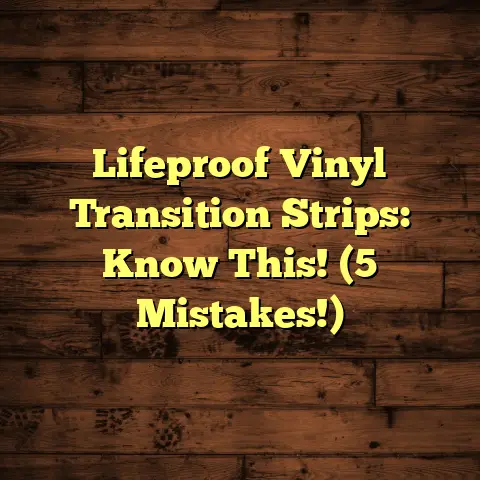Fix Faded Wood Floor? (1 Day Fix Before Refinishing!)
Let’s talk wood floors.
I’m a flooring contractor, and I’ve seen it all when it comes to wood – the good, the bad, and the seriously faded.
Think about your wood floors for a second.
Remember those family gatherings where everyone crammed into the living room?
Or maybe the time your kid decided to “redecorate” with crayons?
Your wood floors have been there, soaking up all those memories.
They’re more than just a surface; they’re a part of your home’s story.
But let’s be honest, time takes its toll. And one of the most common signs of aging?
Faded wood floors.
Before you jump to the expense and hassle of refinishing, I’m here to tell you there’s hope!
Often, a simple, one-day fix can breathe new life into your floors and bring back that warm, inviting glow.
In this article, I’ll walk you through everything you need to know to tackle faded wood floors, including:
- What causes fading in the first place
- How to assess the damage
- A step-by-step guide to a one-day fix
- How to maintain your revitalized floors
- When it’s time to call in the pros
So, grab a cup of coffee, and let’s get started!
Section 1: Understanding Faded Wood Floors
Alright, first things first, let’s understand why your wood floors are fading.
It’s not just some random act of flooring fate! Several factors contribute to this common issue.
-
Sunlight Exposure: This is the biggest culprit. UV rays are brutal!
Think of it like leaving a photo in direct sunlight – it fades over time. The same thing happens to your wood floors.
The lignin in wood (the stuff that gives it its color) breaks down when exposed to UV light.
-
Wear and Tear: Foot traffic, furniture moving, and even pets can wear down the finish on your floors, making them more vulnerable to fading and damage.
-
Cleaning Methods: Using harsh chemicals or abrasive cleaners can strip away the finish and contribute to fading.
I’ve seen people use everything from bleach to ammonia on their wood floors – don’t do it!
-
Type of Finish: Not all wood finishes are created equal.
Some are more resistant to fading than others.
For example, polyurethane finishes tend to be more durable and UV-resistant than older wax finishes.
Oil-based polyurethane typically ambers or yellows over time, while water-based is clearer and resists yellowing.
The type of stain used will also affect how drastically the color shifts over time.
So, which finishes are more susceptible to fading?
Generally, older finishes like varnish or shellac are more prone to fading than modern polyurethane.
Also, darker stains tend to show fading more readily than lighter, natural tones.
How common is this problem?
According to the National Wood Flooring Association (NWFA), faded wood floors are one of the most common complaints they receive from homeowners.
In fact, a survey conducted by the NWFA found that over 60% of homeowners with wood floors reported some degree of fading.
You’re definitely not alone in this!
Section 2: Assessing the Damage
Okay, now that you know what causes fading, let’s take a closer look at your floors.
Grab a flashlight and get down on your hands and knees (yes, really!).
Here’s a step-by-step guide to assessing the damage:
-
Start with a Visual Inspection: Walk around your rooms and look for areas where the color seems uneven or lighter than others.
Pay close attention to areas near windows, doors, and rugs.
These are usually the first places to show signs of fading.
-
Compare Shaded vs. Unshaded Areas: Lift up a rug or move a piece of furniture that has been in place for a while.
Compare the color of the floor underneath to the exposed areas.
If there’s a significant difference, it’s a clear sign of fading.
-
Check for Scratches and Damage: While you’re down there, look for scratches, dents, and other signs of wear and tear.
Are the scratches just on the surface, or do they go deeper into the wood?
This will help you determine whether a simple fix is enough or if you need to consider refinishing.
-
Identify the Type of Finish: If possible, try to determine what type of finish is on your floors.
If you know when the floors were installed, you might be able to ask the previous homeowner or check old records.
Knowing the type of finish will help you choose the right products for your one-day fix.
Fading vs. Scratches: What’s the Difference?
-
Fading: Usually affects large areas and results in an overall lightening or discoloration of the wood.
The wood may look bleached or washed out.
-
Scratches: Are typically localized and appear as distinct lines or marks on the surface of the floor.
They may be the same color as the surrounding wood or lighter, depending on the depth of the scratch.
Can You Fix It, or Is It Refinishing Time?
Here’s a general rule of thumb:
-
Simple Fix: If the fading is mostly on the surface and there are no major scratches or damage, you can probably get away with a one-day fix.
-
Refinishing: If the fading is severe, there are deep scratches or damage, or the finish is peeling or worn away, it’s time to consider refinishing.
I always tell my clients that if more than 30% of the floor needs major repair, refinishing is the more cost-effective option.
Section 3: Preparing for the Fix
Alright, you’ve assessed the damage, and you’re ready to tackle that faded floor!
Before you dive in, let’s make sure you have everything you need.
Here’s a list of tools and materials:
-
Wood Floor Cleaner: Choose a pH-neutral cleaner specifically designed for wood floors.
I recommend Bona or Armstrong – they’re both reliable brands.
-
Wood Floor Restorer: This is the key to reviving faded floors.
Look for a product that is designed to add a protective layer and restore the color and luster of the wood.
-
Some popular options include:
- Rejuvenate Wood Floor Restorer
- Quick Shine Multi-Surface Floor Finish
- Weiman Wood Floor Polish and Restorer
Read reviews and choose one that is appropriate for your type of wood and finish.
-
-
Microfiber Mop or Applicator: A good quality mop or applicator will help you apply the restorer evenly.
I prefer microfiber mops because they’re gentle on the floor and easy to clean.
-
Clean Rags: You’ll need these for wiping up spills and applying the restorer in hard-to-reach areas.
-
Buckets: One for cleaning solution and one for rinsing your mop or rags.
-
Painter’s Tape: To protect baseboards and other areas you don’t want to get the restorer on.
-
Safety Glasses and Gloves: Always protect your eyes and skin when working with chemicals.
-
Ventilation: Open windows and doors to ensure proper ventilation while you’re working.
Step-by-Step Preparation Guide
-
Clear the Room: Remove all furniture, rugs, and other obstacles from the room.
This will give you plenty of space to work and prevent accidents.
-
Sweep or Vacuum: Thoroughly sweep or vacuum the floor to remove any dirt, dust, or debris.
Pay special attention to corners and edges.
-
Clean the Floor: Use your wood floor cleaner to thoroughly clean the floor.
Follow the manufacturer’s instructions carefully.
Make sure to rinse the floor thoroughly to remove any cleaner residue.
-
Let the Floor Dry Completely: Before you apply the restorer, make sure the floor is completely dry.
This may take several hours, depending on the humidity and temperature.
I usually recommend waiting at least 24 hours to be safe.
-
Tape Off Baseboards: Use painter’s tape to protect your baseboards and other areas you don’t want to get the restorer on.
Safety First!
-
Ventilation: As I mentioned earlier, ventilation is crucial.
Open windows and doors to allow fresh air to circulate.
If you’re sensitive to fumes, consider wearing a respirator.
-
Gloves and Eye Protection: Always wear gloves and safety glasses when working with wood floor cleaners and restorers.
These products can be irritating to your skin and eyes.
-
Read the Instructions: Carefully read and follow the manufacturer’s instructions for all products you use.
This will help you avoid mistakes and ensure the best results.
Section 4: The 1-Day Fix Process
Alright, the moment of truth!
You’ve prepped your floor, gathered your supplies, and you’re ready to bring those faded floors back to life.
Here’s a step-by-step guide to the one-day fix process:
Step 1: Cleaning and Prepping the Floor
I know, I know, we already cleaned the floor, but this is a double-check!
Before you apply anything, make sure the floor is absolutely spotless.
-
Remove Any Remaining Debris: Give the floor one last sweep or vacuum to remove any lingering dust or debris.
-
Tackle Stubborn Spots: If you notice any stubborn spots or stains, use a slightly dampened cloth and a mild cleaner to gently scrub them away.
-
Remove Old Wax or Finish (If Necessary): If your floors have a build-up of old wax or finish, you may need to use a wax stripper or finish remover.
Follow the manufacturer’s instructions carefully.
This step is only necessary if you have a significant build-up of old product.
Step 2: Choosing the Right Product
I can’t stress this enough: Read the label!
Make sure the product you choose is compatible with your type of wood and finish.
-
Water-Based vs. Oil-Based: Generally, you should stick with a water-based restorer for water-based finishes and an oil-based restorer for oil-based finishes.
If you’re not sure what type of finish you have, test a small, inconspicuous area first.
-
Color Matching: Some restorers come in different colors to match the stain of your floor.
If you can find a color that is close to your floor’s stain, it can help to blend the faded areas.
-
Sheen Level: Restorers also come in different sheen levels, such as matte, satin, and gloss.
Choose a sheen level that is similar to your floor’s existing finish.
Step 3: Application Techniques
Okay, here’s where the magic happens!
-
Start in a Corner: Begin applying the restorer in a corner of the room and work your way out.
This will help you avoid trapping yourself in a corner.
-
Apply a Thin, Even Coat: Use your microfiber mop or applicator to apply a thin, even coat of the restorer.
Avoid applying too much product, as this can result in a sticky or uneven finish.
-
Work with the Grain: Apply the restorer in the direction of the wood grain.
This will help to blend the product and create a more natural look.
-
Overlap Strokes: Overlap your strokes slightly to ensure complete coverage.
-
Use a Rag for Edges and Corners: Use a clean rag to apply the restorer to edges, corners, and other hard-to-reach areas.
-
Avoid Walking on the Floor: Avoid walking on the floor while the restorer is drying.
If you need to walk across the floor, wear socks or booties to avoid leaving footprints.
Step 4: Drying and Curing Time
Patience is key!
-
Drying Time: The drying time will vary depending on the product you use, the humidity, and the temperature.
Generally, it takes about 2-4 hours for the restorer to dry to the touch.
However, it’s best to wait at least 24 hours before walking on the floor or replacing furniture.
-
Curing Time: The curing time is the amount of time it takes for the restorer to fully harden and bond to the floor.
This can take several days or even weeks, depending on the product.
During the curing time, avoid heavy traffic, spills, and harsh cleaners.
Check the product label.
Pro Tip:
-
Test in an Inconspicuous Area: Before you apply the restorer to the entire floor, test it in a small, inconspicuous area, such as a closet or under a piece of furniture.
This will help you ensure that the product is compatible with your floor and that you like the results.
Section 5: Post-Fix Care and Maintenance
You’ve done it! Your floors are looking refreshed and revitalized.
But the work doesn’t stop there.
To keep your floors looking their best, it’s important to follow a regular maintenance routine.
-
Routine Cleaning: Sweep or vacuum your floors regularly to remove dirt, dust, and debris.
Use a pH-neutral wood floor cleaner to mop the floors as needed.
Avoid using harsh chemicals or abrasive cleaners, as these can damage the finish.
-
Protect from Sunlight: As we discussed earlier, sunlight is a major cause of fading.
Use curtains, blinds, or drapes to block direct sunlight from shining on your floors.
You can also use UV-blocking window film to help protect your floors from the sun’s harmful rays.
-
Use Rugs and Mats: Place rugs and mats in high-traffic areas, such as entrances, hallways, and under furniture.
This will help to protect your floors from scratches and wear and tear.
-
Avoid Water Damage: Wipe up spills immediately to prevent water damage.
Avoid using excessive amounts of water when mopping your floors.
-
Use Furniture Pads: Place felt pads under the legs of furniture to prevent scratches and dents.
-
Regular Maintenance: Every few months, reapply a coat of wood floor restorer to help maintain the shine and protect the finish.
Recommended Products:
-
Bona Wood Floor Cleaner: A pH-neutral cleaner that is safe for use on all types of wood floors.
-
Rejuvenate Wood Floor Restorer: A popular product that adds a protective layer and restores the color and luster of wood floors.
-
Weiman Wood Floor Polish and Restorer: Another great option for reviving faded wood floors.
Section 6: Signs It’s Time to Refinish
Sometimes, no matter how hard you try, a quick fix just isn’t enough.
Here are some signs that it’s time to consider refinishing your wood floors:
-
Severe Fading: If the fading is so severe that it’s not responding to a restorer, it’s time to refinish.
-
Deep Scratches or Damage: If there are deep scratches, dents, or other damage that can’t be repaired with a simple fix, refinishing is the best option.
-
Peeling or Worn Finish: If the finish is peeling, cracking, or worn away in large areas, it’s time to refinish.
-
Water Damage: If your floors have suffered significant water damage, refinishing may be necessary to repair the damage and prevent further problems.
-
Uneven Finish: If the finish is uneven or blotchy, refinishing can help to create a smooth, consistent surface.
Quick Fix vs. Full Refinishing: What’s the Difference?
-
Quick Fix: A quick fix involves cleaning the floor, applying a restorer, and taking steps to prevent future damage.
It’s a relatively inexpensive and easy way to revive faded floors.
-
Full Refinishing: Full refinishing involves sanding down the existing finish, staining the wood (if desired), and applying several coats of polyurethane.
It’s a more expensive and time-consuming process, but it can completely transform the look of your floors.
Cost:
- Quick Fix: \$50-\$100 (for products)
- Full Refinishing: \$3-\$8 per square foot (professional refinishing)
Time:
- Quick Fix: 1 day
- Full Refinishing: 3-5 days
End Results:
- Quick Fix: Refreshed and revitalized floors with improved shine and color.
- Full Refinishing: Completely transformed floors with a new finish and color (if desired).
Conclusion: Reviving Memories
So, there you have it!
Everything you need to know to fix faded wood floors in a single day.
I hope this article has empowered you to take on this project and bring new life to your floors.
Remember those memories we talked about at the beginning?
Your wood floors are more than just a surface; they’re a part of your home’s story.
By taking the time to restore them, you’re not just improving the look of your home, you’re preserving those precious memories for years to come.
So, go ahead, grab your supplies, and get to work!
You’ll be amazed at the difference a little bit of effort can make.
And who knows, maybe you’ll even create some new memories along the way!
Happy flooring!





